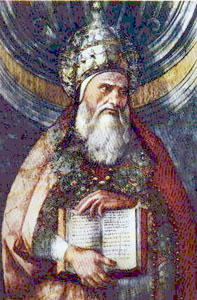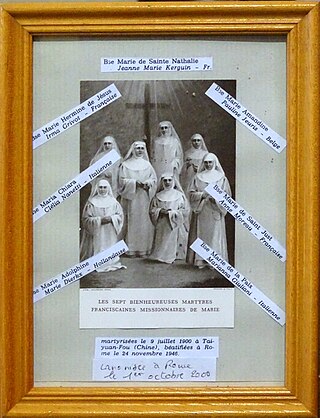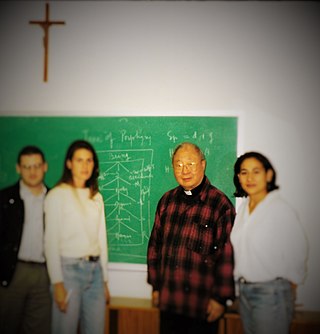Related Research Articles

Pius I was the bishop of Rome from c. 140 to his death c. 154, according to the Annuario Pontificio. His dates are listed as 142 or 146 to 157 or 161, respectively. He is considered to have opposed both the Valentinians and Gnostics during his papacy. He is considered a saint by the Catholic Church and the Eastern Orthodox Church with a feast day in 11 July, but it is unclear if he died as a martyr.
The Venerable is a style, title, or epithet used in some Christian churches.
The history of the Catholic Church is integral to the history of Christianity as a whole. It is also, according to church historian Mark A. Noll, the "world's oldest continuously functioning international institution." This article covers a period of just under two thousand years.
This article lists the feast days of the General Roman Calendar as they were at the end of 1954. It is essentially the same calendar established by Pope Pius X (1903–1914) following his liturgical reforms, but it also incorporates changes that were made by Pope Pius XI (1922–1939), such as the institution of the Feast of Christ the King, and the changes made by Pope Pius XII (1939–1958) prior to 1955, chief among them the imposition of the Feast of the Immaculate Heart of Mary upon the universal Church in 1944, the inscription of Pius X into the General Calendar following his 1954 canonization, and the institution of the Feast of the Queenship of Mary in October 1954.
Pope Pius XII and the Church in China involves relations of the Holy See with China from 1939 to 1958. The Vatican recognized Chinese rites in 1939, elevated the first Chinese cardinal in 1946, and established a Chinese hierarchy.
Cupimus imprimis is an apostolic letter of Pope Pius XII to all the faithful in China regarding their persecutions and the persecution of the Catholic Church.
Persecutions against the Catholic Church took place during the papacy of Pope Pius XII (1939–1958). Pius' reign coincided with World War II (1939–1945), followed by the commencement of the Cold War and the accelerating European decolonisation. During his papacy, the Catholic Church faced persecution under Fascist and Communist governments.
The liturgical reforms of Pope Pius XII took place mostly between 1947 and 1958.

Rémy Isoré was a French Jesuit priest, he was martyred during Boxer Rebellion in China. He was declared a saint by Pope John Paul II in 2000.
Anna Wang was a Catholic lay girl who was martyred during the Boxer Rebellion. She was declared a saint by John Paul II. She is one of the Martyrs of China.

Marie of Saint Natalie, born Jeanne-Marie Guerguin was one of the 120 Martyrs of China.
The Pius War refer to debates over the legacy of Pope Pius XII and his actions during the Holocaust. The phrase was first coined in a 2004 book of the same name.

Saint Marie-Adolphine Dierkx was a Dutch nun who died for her faith in China during the Boxer Rebellion and was canonised in 2000. She is one of the group known as the Martyr Saints of China who were canonised by Pope John Paul II on 1 October 2000. Her birthplace has been converted into a chapel.

Saint Marie-Hermine of Jesus was a French nun and Mother Superior who died during the Boxer Rebellion in China and was canonised in 2000. She and six other nuns had gone to China to create a small hospital and to staff an orphanage, but were ultimately killed due to their association with foreign interference. She is one of the group known as the Martyr Saints of China who were canonised by Pope John Paul II 1 October 2000.
Saint Maria Chiara Nanetti or Mary Clare was an Italian religious sister who died for her faith in China during the Boxer Rebellion and was canonised in 2000. She is one of the group known as the Martyr Saints of China who were canonised by Pope John Paul II 1 October 2000.
Saint Marie de la Paix Giuliani was an Italian religious sister who died for her faith in China during the Boxer Rebellion and was canonised in 2000. She is one of the group known as the Martyr Saints of China who were canonised by Pope John Paul II 1 October 2000.

Mark Ji Tianxiang was a Chinese lay Catholic and doctor. He was martyred during the Boxer Rebellion and had been an opium addict. He was canonized in 2000 by Pope John Paul II.

Matthias Lu was a Roman Catholic priest and Thomist philosopher. He served as vicar to East Asian Catholics for the Diocese of Oakland from 1969 to 1986.
References
- 1 2 3 4 "Saints and Blesseds: Q… – RD…". www.gcatholic.org. Retrieved 2021-12-25.
- 1 2 3 4 "Saint Raimundus Li Quanzhen". CatholicSaints.Info. 2013-06-28. Retrieved 2021-12-25.
- ↑ CNA. "120 Martyrs of China". Catholic News Agency. Retrieved 2021-12-26.